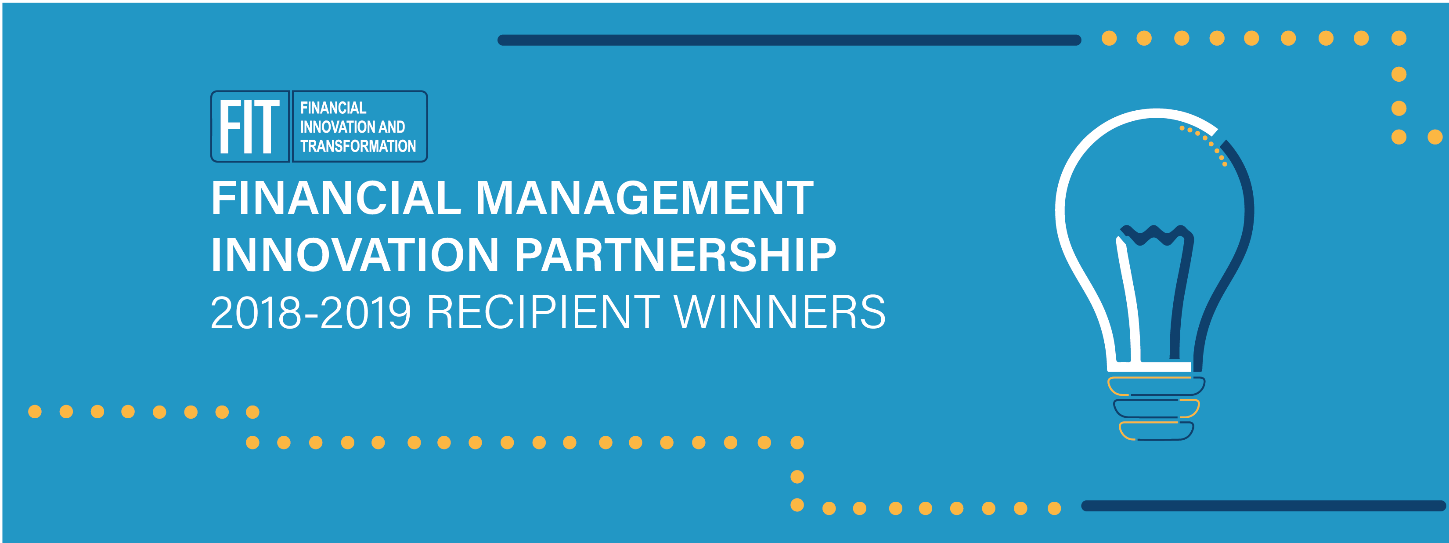

FMIP 2018-2019 Award Recipients

Congratulations to the 2018-2019 Financial Management Innovation Partnership award recipients!
2019 Award Recipient

Department of Health and Human Services (HHS)
HHS had over one thousand appropriations managed across three Oracle accounting systems. Each system had a distinct change management process that operated independently, limiting data standardization and information sharing. Also, each Operating Division houses large amounts of information/guidance that was not readily accessible and often overlooked.
The goal of this project is to combine intelligent automation concepts such as application processing interface (API) and robotics process automation (RPA) with enterprise-wide workflow integration (ServiceNow Platform-as-a-service) to improve financial management processes across the HHS financial management environment.
The pilot for this project will use the JavaScript Object Notation (JSON) file structure for data interchange allowing HHS to rapidly respond to USSGL updates in near real-time rather than searching through PDF and Excel files.
As new Treasury Financial Manual (TFM)/USSGL publications are posted, RPA will give HHS the ability to automatically create new tickets in their change management environment and track all updates to their financial management systems.
HHS will better meet the demands of their customers and stakeholders by increasing productivity, quality, compliance, and availability. As part of this pilot they anticipate the following outcomes:
- Productivity: Estimated 40% cut in time wasted performing repetitive manual processes such as reviewing TFM bulletin PDFs and related USSGL documents line by line.
- Quality: Integrated automation will end processes involved with manually reconciling TFM and HHS policy and cut errors by an estimated 20%.
- Compliance: Integration of the digitized guidance will allow HHS to give the most up-to-date and accurate accounting guidance and policy to its customers and stakeholders.
- Availability: Cuts time on low-value administrative work and will result in an estimated 60% increase in availability for staff to engage in high value work.
2018 Award Recipients

National Science Foundation (NSF)
Like many federal entities, NSF faced issues with limited resources resulting from decreased contract support, reduced federal hiring and increased regulatory requirements. Based on the first proofs of concept in 2017, NSF determined that RPA could help with resource issues and identified several processes that were repetitive, time intensive and error prone to be considered for automation.
NSF socialized RPA across the agency, set up an internal governance structure and then identified two processes to automate through a pilot using RPA: 1) automate an alerting system that NSF uses from Treasury called the Invoice Processing Platform; and 2) processing of joint grants or intra-agency purchases through the Intra-Government Payment and Collection system. These two automation efforts combined, both now in production, saved NSF staff 600+ hours annually, cut transaction processing time by 90%, and increased employee morale by allowing them more time to perform analytical work to grow both technically and professionally.
NSF’s first proofs of concept and subsequent pilots of RPA technology opened the door for future automation. Not only has NSF been successful in implementing RPA across the agency, they have also been a leader for the entire government through sharing their internal governance structure and control plans with other agencies on their RPA journey.

Department of Interior (DOI)
To improve procurement, DOI contracted a closeout robot by implementing RPAto cut employees’ workload and errors associated with closing contracts.
DOI created the RPA program from the ground up, including incorporating bots into regular system governance and deciding which opportunities are best for bots, compared to other automation options. DOI also needed to build their own bot technical knowledge, starting with automating aspects of the Award Closeout processes using simplified acquisitions of $100 or less.
During phase one of production, DOI discovered the bot encountered challenges with error handling. Once those limitations were fixed, DOI was able to move forward with phase two, to increase the limit of contract amounts from $100 to $10,000.
DOI’s bot benefitted stakeholders, because contracting officers would more efficiently identify and close out contracts and project managers got timely return of budget authority for re-obligation.
The bot also provided benefits finding unused funds by crawling to look at DOI’s contracts (estimated $3B annually). Besides contract closeouts, the bot also created draft modifications for simplified acquisitions with open balances of $100 or less, a process that took contracting staff 15 minutes for each contract.
In the end, DOI’s bots have saved over 600 hours of staff time a year, allowing staff to identify, analyze, and resolve discrepancies that previously were not identified or required extensive manual intervention.
